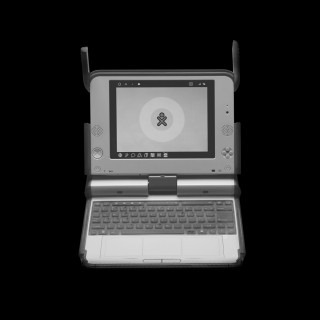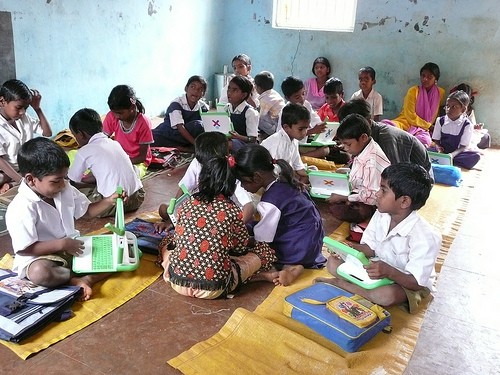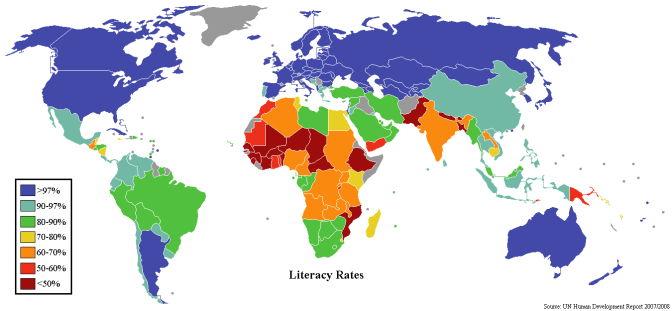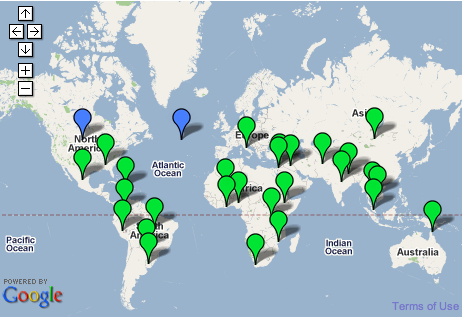- Manufacturer: One Laptop per Child
- Designer: Yves Behar
- Material: polycarbonate
- Dimensions: 24 × 23 × 3 cm
- www.laptop.org

Index
- Ambition The origins of One Laptop Per Child (OLPC) stretch back more than four decades to the primordial days of computing, when most machines were still the
- Value 'The target has been $100 […] And we'll get there before the end of 2009,' Negroponte said. 'The price will get down to $50 in 2011.' Benefits To crea
- Design Yves Behar is the founder of the San Francisco design studio, fuseproject. Yves is focused on humanistic design and the 'giving' element of his profes
- Activities There are no software applications in the traditional sense on the laptop. The laptop focuses children around 'activities.' which are distinct from ap
- Aptitude Children - especially young children - need the opportunity to learn far more than Word, Excel, and Powerpoint. Of course, picking up these skills, ha
- Literacy 'Everyone has the right to education. Education shall be free, at least in the elementary and fundamental stages. Elementary education shall be compul
- Distribution Uruguay 227,000 Peru 175,000 Mexico 50,000 Birmingham, AI, USA 14,000 Haiti 13,800 Rwanda 10,000 Mongolia 10,000 Nepal 6,000 Ethiopia 5,900 Oceania 5,
- Advertising The One Laptop Per Child (OLPC) project appears to have taken advertising to a whole new level, as the non-profit organization is trying to promote it
- Square Eyes For all the schools and parents who have together invested billions to give children a learning edge through the latest computer technology, a mammoth
The origins of One Laptop Per Child (OLPC) stretch back more than four decades to the primordial days of computing, when most machines were still the size of small dinosaurs and next to no one imagined they had any connection to children. Pioneering thinkers such as Seymour Papert dreamed they would be suitable for children, and time has proven the immense power of the personal computer as a learning tool.
Provision
The One Laptop Per Child Association, Inc. (OLPC) is an [American] non-profit organisation set up to oversee the creation of an affordable educational device for use in the developing world. Its mission is 'To create educational opportunities for the world's poorest children by providing each child with a rugged, low-cost, low-power, connected laptop with content and software designed for collaborative, joyful, self-empowered learning.' Its current focus is on the development, construction and deployment of the XO-1 laptop.
The organization is led by chairman Nicholas Negroponte, and Charles Kane, President and Chief Operating Officer. OLPC is a 501(c)(3) organization registered in Delaware, USA and is funded by member organizations, including AMD, Brightstar Corporation, eBay, Google, Marvell, News Corporation, SES, Nortel Networks, and Red Hat. Each company has donated two million dollars.
OLPC has generated a great deal of interest in the Information and Communication Technologies for Development (ICT4D), in education and one to one computing fields of research.
'It's an education project, not a laptop project.'
Nicholas Negroponte was a co-founder and director of the MIT Media Laboratory, and the Jerome B. Wiesner Professor of Media Technology at MIT. Nicholas is a pioneer in the field of computer-aided design, and has been a member of the MIT faculty since 1966. Conceived in 1980, the Media Laboratory opened its doors in 1985. He is also the author of the 1995 bestseller, Being Digital, which has been translated into more than forty languages. In the private sector, Nicholas serves on the Board of Directors for Motorola, Inc. and as a general partner in a venture capital firm specializing in digital technologies for information and entertainment. He has provided start-up funds for more than thirty companies, including Wired magazine.
'The target has been $100 […] And we'll get there before the end of 2009,' Negroponte said. 'The price will get down to $50 in 2011.'
Benefits
To create educational opportunities for the world's poorest children by providing each child with a rugged, low-cost, low-power, connected laptop with content and software designed for collaborative, joyful, self-empowered learning. When children have access to this type of tool they get engaged in their own education. They learn, share, create, and collaborate. They become connected to each other, to the world and to a brighter future.
Features
Education means a chance for a better life. But for the majority of the children in the developing world, access to education remains difficult. Nicholas Negroponte worked with FuseProject to create a low-cost laptop specifically adapted to children and their environment. Providing strategic solutions to the making of the XO [the $100 laptop], which led to the unique configuration and innovations that make the XO a true industry game changer. The design intent was to make the XO [the $100 laptop] immediately recognizable as a child's product, but not like a toy: the laptop's look and feel is of a high-quality tool for education. Specific friendly design elements such as the soft edges, rubber keyboard, or turning the burdensome collaborative Wi-Fi antennas into whimsical rabbit ears, adds a childlike feel to the laptop.
Yves Behar is the founder of the San Francisco design studio, fuseproject. Yves is focused on humanistic design and the 'giving' element of his profession, with the goal of creating projects that are deeply in-tune with the needs of a sustainable future, connected with human emotions and enable self-expression.
For Nicholas Negroponte's One Laptop Per Child (OLPC) organization, fuseproject designed the world's first $100 'XO' laptop aimed at bringing education and technology to the world's poorest children.
There are no software applications in the traditional sense on the laptop. The laptop focuses children around 'activities.' which are distinct from applications in their foci. Collaboration and expression — and their implementation — journaling and iteration. In order to facilitate a collaborative learning environment, the laptops have networking capabilities which allow them to see and interact with each other. By exploiting this connectivity, every activity has the potential to be a networked activity. The laptop is a 'thing to think with.' We hope to make the primary activity of the children one of creative expression, in whatever form that might take. Thus, most activities will focus on the creation of some type of object, be it a drawing, a song, a story, a game, or a program.
'Learning is our main goal.'
Features
The laptop has a bespoke Linux operating system (OS) developed by leading open source software company Red Hat. In contrast to sometimes costly proprietary software, open source software is free and allows users to access and alter the code. one laptop per child (OLPC) hopes some children will tinker with the code to develop new programs. Its user interface is known as Sugar. It includes standard programs such as a web browser based on Firefox; a word processor able to handle most common document types, a PDF reader and media player. In addition, it comes with games, a music creation tool and drawing programs. [...]
Designed for use in outdoor classrooms, the full-colour transmissive mode is similar to any other Liquid Crystal Display (LCD), but in ultra low-power black-and-white mode the screen is readable in direct sunlight. The hard-wearing green and white plastic case is designed to be as waterproof and dustproof as possible for children walking to and from school. A range of power supplies are available to countries buying the laptop. For areas with an electricity supply, the computer can be used with an 18W power adapter. In areas without access to the grid, various contraptions have been designed to plug directly into the laptop including a solar panel, a hand crank, a foot pedal and a pull-string recharger. The laptop was a feat of energy efficiency and engineering, running on 10 percent of the energy traditional laptops required.
Children - especially young children - need the opportunity to learn far more than Word, Excel, and Powerpoint. Of course, picking up these skills, having grown up with a laptop, will be readily accomplished.
Epistemologists from John Dewey to Paulo Freire to Seymour Papert agree that you learn through doing. This suggests that if you want more learning, you want more doing. Thus OLPC puts an emphasis on software tools for exploring and expressing, rather than instruction. Love is a better master than duty. Using the laptop as the agency for engaging children in constructing knowledge based upon their personal interests and providing them tools for sharing and critiquing these constructions will lead them to become learners and teachers.

Mental Nourishment
Most of the nearly two–billion children in the developing world are inadequately educated, or receive no education at all. One in three does not complete the fifth grade. The individual and societal consequences of this chronic global crisis are profound. Children are consigned to poverty and isolation — just like their parents — never knowing what the light of learning could mean in their lives. At the same time, their governments struggle to compete in a rapidly evolving, global information economy, hobbled by a vast and increasingly urban underclass that cannot support itself, much less contribute to the commonwealth, because it lacks the tools to do so.
Case Study
Earlier this year, Matt Keller sat down with officials in Afghanistan - not to discuss troop deployments, suicide bombings or opium traffickers. He was there to talk about getting laptop computers into the hands of little girls. As Taliban insurgents continue to crack down on girls who go to school and women who dare to teach them, Keller was awestruck by the Afghan government's determination to educate all children, even if it means finding tools that allow them to intellectually grow in the privacy of their own homes. 'For them to propose this was astounding' said Keller, who works for One Laptop Per Child (OLPC), a Cambridge, Massachusetts, nonprofit committed to creating and distributing laptops to the world's poorest children. 'That hunger for knowledge, that desire to learn, is pretty profound.' From Uruguay, Haiti and Mexico to Mongolia, Ghana and the small Polynesian island of Niue, at least 750,000 kids - a number that will double by June, Chairman Nicholas Negroponte said - are tapping away on One Laptop Per Child (OLPC)- produced XO laptop keyboards. [...]
Cavallo spoke of a school in Rwanda that lacks electricity and traditionally had a 50% attendance rate. It is now drawing 1,000 more students than its previous full capacity, he said, and is even attracting kids - who in turn are teaching their parents and grandparents - on weekends.

'Everyone has the right to education. Education shall be free, at least in the elementary and fundamental stages. Elementary education shall be compulsory.' 26th Human Rights Act

- Uruguay 227,000
- Peru 175,000
- Mexico 50,000
- Birmingham, AI, USA 14,000
- Haiti 13,800
- Rwanda 10,000
- Mongolia 10,000
- Nepal 6,000
- Ethiopia 5,900
- Oceania 5,000
- Paraguay 4,000
- Brazil 2,600
- Afghanistan 2,500
- Colombia 1,680
- Palestinian Territories 1,000
- Cambodia 1,000
- Ghana 1,000
- Iraq 950
- India 700
- Italy 600
- Thailand 500
- South Africa 450
- Lebanon 450
- Mozambique 200
- Malaysia 100
- Mali 30
The One Laptop Per Child (OLPC) project appears to have taken advertising to a whole new level, as the non-profit organization is trying to promote its XO [the $100 laptop] around the world. Following a series of new advertising spots, a rather strange, but also interesting commercial started airing on Christmas Day on national television outlets. The thing that sets this ad apart from all the others is that it features one of the greatest figures in rock and roll music, more specifically John Lennon. The face, name and voice of the music legend have been put to use in one of the latest video advertisements of OLPC's XO.
In the video, John Lennon, one of the two founding members of the Beatles band, tries to convince people to sustain the cause of the OLPC project. 'Imagine every child no matter where in the world they were could access a universe of knowledge. They would have a chance to learn, to dream, to achieve anything they want. I tried to do it through my music, but now you can do it in a very different way. You can give a child a laptop and more than imagine, you can change the world.'
The image and voice of John Lennon have been modified, using modern digital technology, so that the message of the advertisement can be clearly transmitted to the audience. The rights of using the voice and image of the music legend have been granted by the dead singer's wife, Yoko One, who probably felt very strongly about OLPC's mission.
In an attempt to speed up the adoption of the OLPC, the non-profit organization also created two other advertisements, one that features Tom Brady, an American football quarterback for the New England Patriots, and another one that shows controversial and violent footage of children being involved in warfare and prostitution.
www.youtube.com/watch?v=4b4GkGMiBDQFor all the schools and parents who have together invested billions to give children a learning edge through the latest computer technology, a mammoth new study by German researchers brings some sobering news: Too much exposure to computers might spell trouble for the developing mind.
From a sample of 175,000 15-year-old students in 31 countries, researchers at the University of Munich announced in November that performance in math and reading had suffered significantly among students who have more than one computer at home. And while students seemed to benefit from limited use of computers at school, those who used them several times per week at school saw their academic performance decline significantly as well.
'It seems if you overuse computers and trade them for other [types of] teaching, it actually harms the student,' says lead researcher Ludger Woessmann in a telephone interview from Munich. [...] In surveying the gamut of research for his 2003 book 'The Flickering Mind' (Random House), journalist Mark Oppenheimer found most studies have overstated either the benefits or the drawbacks computers pose in education. The most thorough studies have found computers to have little effect either way, he said, although some guiding principles are beginning to emerge.
'They get anxious, restless, bored and aggressive'
Technology access has been linked to improved reading skills, but some believe that too much technology can impose dangers on today's youth - including vision impairment, technology addiction and sexual solicitation.To be sure, technology opens the doors to a world that includes much more than convenience, knowledge and entertainment.
'Their brains get used to too much auditory and visual stimulation - and in the absence of these stimulations, they do not know what to do with themselves. They get anxious, restless, bored and aggressive.' said Mali Mann, M.D., adjunct clinical assistant professor of psychiatry and behavioral science at Stanford University's School of Medicine. […] What's more, a third of children - many as young as 11 years old - use blogs and social networking sites at least two or three times a week. Yet two-thirds of parents don't even know what a blog is, according to a report by NCH Children's Charities and Tesco Telecoms. […]
'Too much technology exposure can lead to inattentiveness in the classroom setting for school-aged children. They may get diagnosed incorrectly with Attention Deficit Disorder or Attention Deficit Hyperactivity Disorder, or even be erroneously labeled with bipolar disorder,' Mann stressed. 'These kids do not show interest in healthy physical exercise, and [they] lose interest in sports.'

































































































